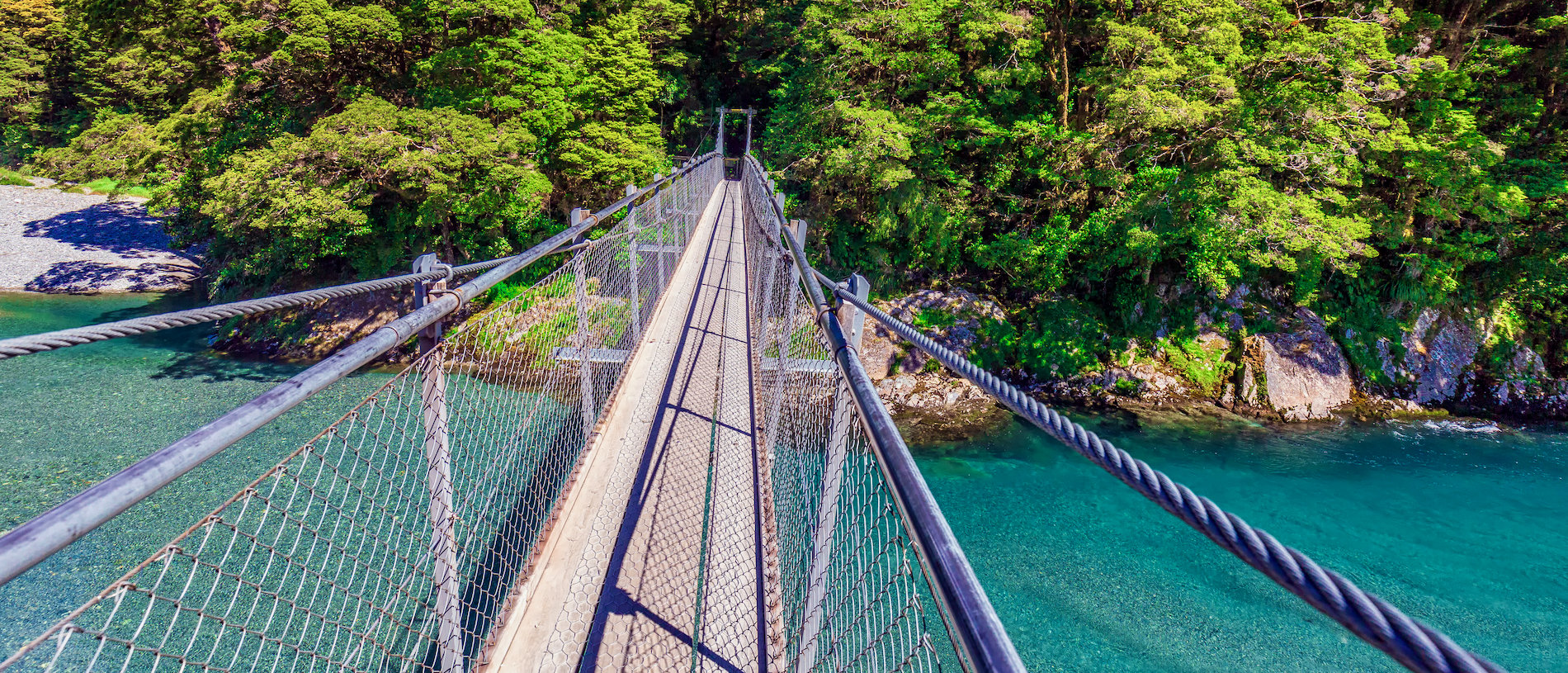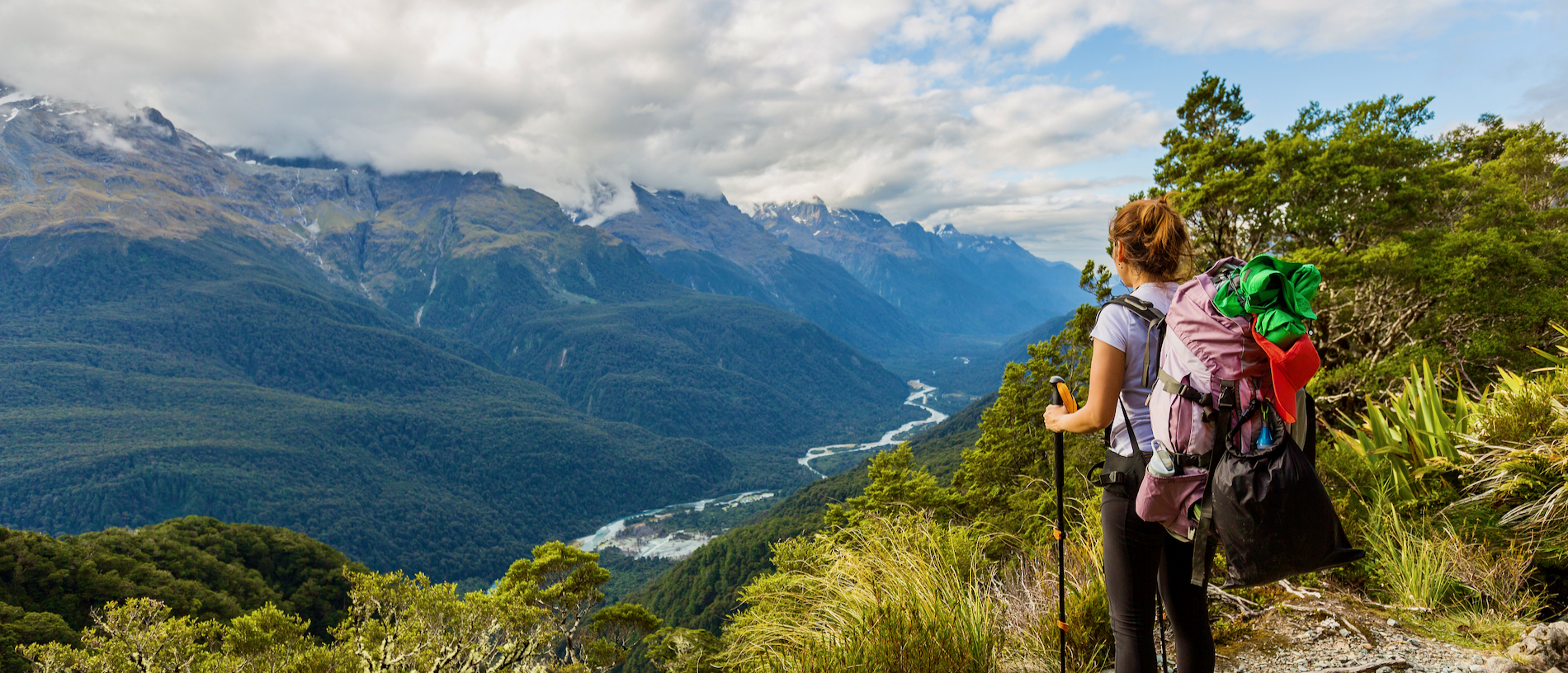
Get outdoors: 14 must-do short walks
New Zealand is blessed with so many beautiful and varied landscapes. Often the best way to discover them is on foot.

Known in other countries as hiking, bushwalking or trekking, tramping is a uniquely New Zealand term and one fitting the style of walking encountered here – often rough, frequently wet, but regularly inspiring.
New Zealand is arguably the best country in the world in which to tramp. Very few other countries offer such a diversity of terrain, ranging from coastal to mountain, in such a small area.
We have tracks in areas that feature active volcanoes, hot springs, moss-laden rainforests, ragged fault ranges, glacier-carved valleys, island-studded lakes and golden-sand coastlines.
Because New Zealand has been isolated from other landmasses for over 65 million years, our flora and fauna are unique. Creatures like the kea (the only alpine parrot in the world) and plants like the cabbage tree (the world’s tallest lily) help make the experience of tramping here distinctive.
The network of tracks and huts maintained by the Department of Conservation is rarely bettered anywhere else. Only a few countries, such as Norway and Italy, have anything like the number of backcountry huts that New Zealand does. However, unlike many European nations, most New Zealand huts are self-catering, so trampers need to be fully self-reliant for food, cookers, sleeping bags and equipment – preserving something of pioneer traditions.
There are a few exceptions on the Milford, Routeburn, Hollyford and Greenstone-Caples tracks, where companies offer a catered, guided option using private huts.
There are tramps to suit everyone throughout New Zealand, reflecting a range of length, difficulty, terrain and natural history with plenty for the novice or casual tramper.
New Zealand has nine ‘Great Walks’ (and one ‘great paddle’: the Whanganui Journey which is a trip for kayakers, not trampers). These are considered New Zealand’s premier tracks and most, quite rightly, have become internationally renowned – most notably the Milford track, which carries the by-line ‘the finest walk in the world.' All Great Walks have facilities of a higher standard than most other New Zealand tramping tracks, but due to their popularity, all have a booking system in place for huts and campsites.
This long-distance trail runs the length of New Zealand, from Cape Rēinga in the north to Bluff at the bottom of the South Island. Officially opened in 2011, the 3000-km trail is New Zealand’s equivalent of the Appalachian or Pacific Crest Trail in the USA, the Bibbulman in Australia, or the Pennine Way in Britain.
Te Araroa follows the route of several tracks, including the Queen Charlotte and Harper Pass tracks and parts of the Travers-Sabine circuit, St James Walkway and Cass–Lagoon Saddle Track.
Bear in mind that the level of difficulty of a tramp depends very much on the season and weather conditions. Wet weather could turn a medium tramp into a hard or even impossible one, while winter snow may transform a medium trip into one that requires mountaineering skills. Generally, I would apply the following guidelines:
Length is a less reliable indication of effort required than the time. On a good surface, like on most Great Walks, a fit tramper may cover 4-6kph. But on a rough track, travel is usually more like 2kph and sometimes slower. The degree of climbing and descent naturally affects your speed as well. A good rule of thumb is about 300m of ascent per hour.
Wild places change constantly. Floods alter rivers, volcanoes erupt from time to time and storms or earthquakes can devastate forests and tracks. Careless fires do reduce huts to ashes surprisingly frequently, and the condition of tracks and huts varies depending on how recently they have been maintained. Trampers should always check with the local Department of Conservation (DOC) visitor centre for updates before their trip.
If you do find any safety hazards – such as a bridge washed out, or a new slip on a track – report it to DOC as soon as you can.
New Zealand’s temperate latitude fools some visitors into thinking that the weather will always be mild. In reality, our position in the path of the Roaring Forties and mountainous terrain combine to produce some of the most changeable and unpredictable climates on the planet. In the mountains, snow can fall at any time of year, although it's obviously rarer during summer. Some parts of New Zealand, particularly the West Coast and Fiordland, experience some of the highest rainfall in the world – seven to nine metres of rain falls at Milford Sound annually, while in 1998 a West Coast valley near Hokitika received more than 15m of rain! Heavy rain can make sections of some tracks impassable and rivers unfordable in just a few hours.
Trampers need to plan around the weather. Always check the forecast before you leave and be prepared to change your plans accordingly.
If river levels rise overnight, wait another night at the hut or camp. Once the rain stops, river levels usually fall as quickly as they rose.
Taking into account the amount of daylight is also important when planning your tramp. During mid-summer Stewart Island experiences 16 hours of daylight, but by mid-winter, this reduces to as little as eight hours. The difference is not so extreme further north, but even in Northland, you can only expect 10 hours of daylight around the winter solstice.
New Zealand’s hut network – which includes over 1000 back-country huts – is unique in the world, but requires our support if it is to be maintained. Most huts are owned and managed by DOC, although a significant number are maintained by tramping, hunting and alpine clubs.
DOC charges small hut fees for staying overnight in most huts, excepting very small huts or bivs, which are free. However, hut fees don't come close to covering the cost of maintaining all New Zealand’s tracks and huts, let alone replacing those that are occasionally destroyed by fires or fall down from old age. By paying hut fees, you are doing your bit to enable future generations to enjoy the backcountry. Hut tickets can be purchased from most DOC offices and information centres, and Great Walk hut bookings can be made online.
Most huts have logbooks for visitors to record their journey. These not only provide a record for search and rescue purposes but often contain amusing anecdotes or interesting information on alternative routes.
At night or during bad weather, the hut forms the focus of the tramping experience and is part of the New Zealand’s backcountry tradition. A few simple courtesies help make the experience enjoyable for everyone.
Always make room for newcomers, even if the hut is nearing capacity. When the hut is full, consider using a tent if you have one. Inside, keep your gear tidy and contained and remove wet boots to keep the floor clean and dry. When leaving, make sure all benches and tables are clean, sweep the floor, close all windows and doors, and ensure you’ve replaced any firewood used. If you have room in your rubbish bag, consider taking out any leftover detritus – it’s surprising how quickly huts can fill with ‘forgotten’ waste.
You can’t go too wrong if you follow the rule: ‘leave the hut as you would hope to find it.’
New Zealand backcountry is blessed with some of the cleanest water on the planet. Take care when camping or toileting to ensure it stays that way.
Don't use soap or detergent in lakes or streams and, where possible, use toilets. If there is no long-drop, go to the toilet at least 100m away from water sources and bury your waste. When camping, take care not to pitch your tent in a fragile area and avoid hacking poles out of saplings.
The water-borne parasite Giardia can be present in some backcountry waterways, but there are still significant areas where you can safely drink straight from the stream. If in doubt, carry water treatments, boil the water for five minutes or use a water filter.
Have consideration for the environment. Don’t take anything natural and don’t leave anything unnatural.
It should go without saying that you should carry out all your rubbish and any you find. Avoid lighting fires when they are unnecessary or during a fire ban. When they are necessary, keep fires small and, where they exist, use pre-existing fireplaces.
Before you head for the hills, leave your trip intentions, including possible bad weather alternatives, with a friend who can be relied upon to contact the police Search and Rescue (SAR), in the event of your party becoming overdue. During your tramp you should also fill in hut books, even if you do not stay in the hut so that your route can be followed. Consider carrying a PLB (personal locator beacon), also known as an EPIRB, to alert authorities in the event of an accident or emergency. Many clubs and outdoor stores also hire these out.
Rivers are the biggest hazard in the backcountry and cause the most deaths. You should know the current New Zealand Mountain Safety Council river-crossing techniques before you go, and practice these before needing them in a real situation. Many tramping clubs offer introductory courses on river crossing, bushcraft and navigation. The website of the Federated Mountain Clubs has a list of affiliated tramping and alpine clubs.
The New Zealand Mountain Safety Council also has many good brochures and manuals on safety in the outdoors.
Few animals in New Zealand pose much threat to trampers. There are no snakes or large carnivorous mammals and only one poisonous spider – the very rare katipo that lives only in coastal areas. Introduced pigs and deer will normally try to avoid you, but can be dangerous if threatened. The main hunting season for deer is during March and April when trampers should be aware of the presence of hunters.
Wasps are a significant hazard, particularly during summer and autumn. In the parks around Nelson and the upper West Coast, wasps have almost reached plague proportions. Carry anti-histamine cream and tablets, and wear gaiters to minimise the risk of stings.
On the coastal section of tracks like the Hollyford or Northwest Circuit, you may encounter New Zealand fur seals. It is best to observe them from a respectful distance and avoid getting between them and their escape route into the sea. Bull seals can be aggressive during the mating season, as can females when they have pups.
Two native birds, the kea and the weka often delight trampers with their antics, but both will thieve gear if given an opportunity.
Kea may even destroy unattended tents and are particularly mischievous areas like Cascade Saddle and Arthur’s Pass. Please refrain from feeding kea or weka; human foods are bad for their health, and encourage them into more trouble!
Finally, happy tramping. May the weather god Huey smile benevolently during your trip!